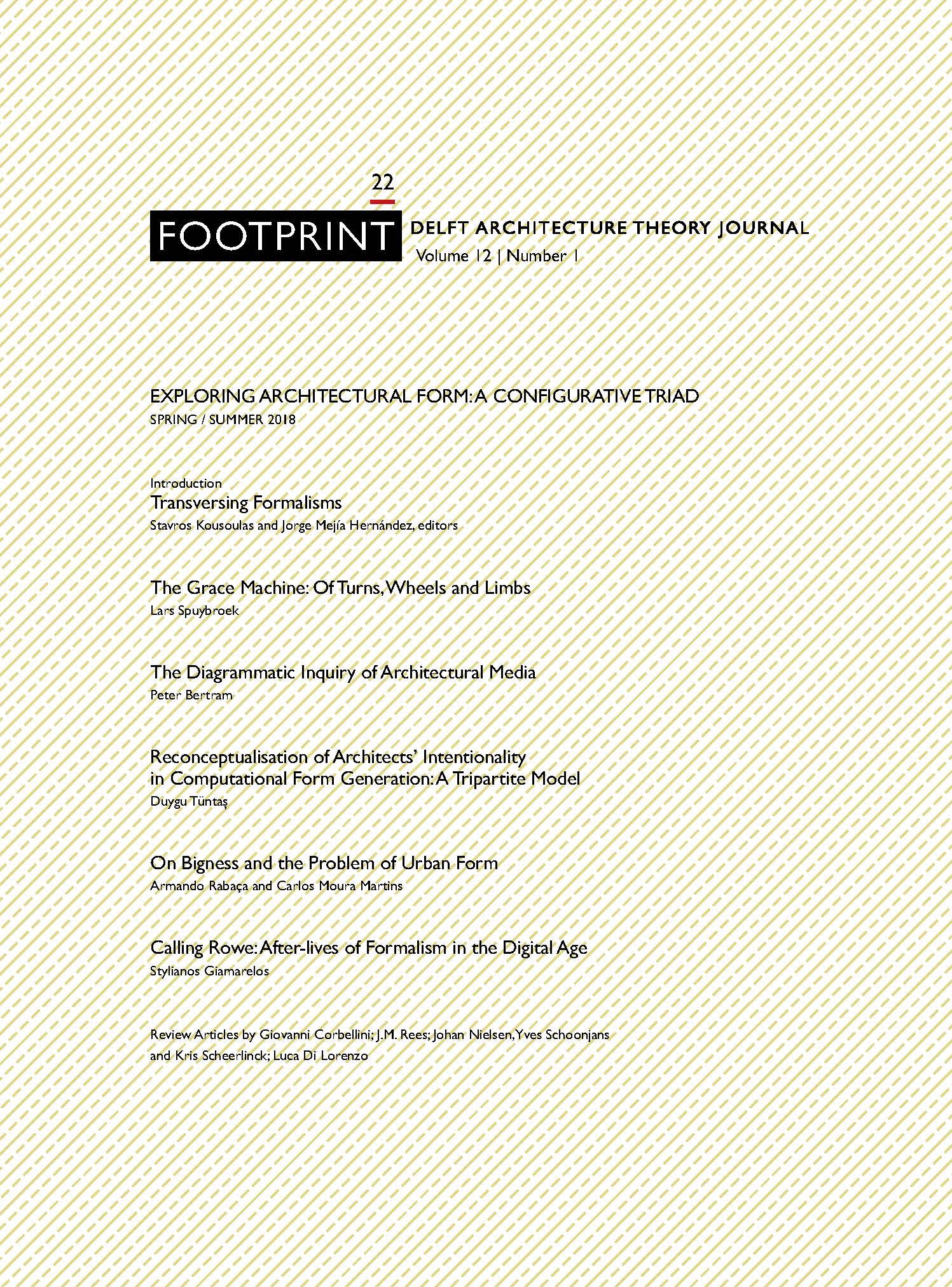'Des Yeux Qui Ne Voient Pas...': The smartphones
DOI:
https://doi.org/10.7480/footprint.12.1.1778Abstract
Three of the most influential chapters of Le Corbusier’s Vers une Architecture are collected under the common title ‘Des yeux qui ne voient pas…’ (Eyes which do not see…). Liners, airplanes, and automobiles are shown as the expression of the powerful beauty of practical form: honest, simple, functional and technological. These very famous pages remind us that form is not only derived from precise typological choices or from reasoned morphogenetic diagrams, but it could also be a direct expression of the Kunstwollen.
What are the paquebots of the twenty-first century? Which buildings embody this new paradigm? This graphic analysis starts from the statement that one of the ‘not seen’ features of this era is the smartphone. The subject of the survey is the first BMW Guggenheim Lab, designed in 2010 by Atelier Bow-Wow. Described by the architects themselves as a ‘travel toolbox’ or ‘pop-up fly loft theatre in the city’, this compact architecture is the incarnation of three interesting formal qualities usually associated with smartphones: the clear division between the hardware and the ergonomic user interface; the possibility to operate different functions (or software) in the same space (or screen); and the real and virtual connection with different urban situations.
References
Atelier Bow-Wow, Tokyo Institute of Technology, and Tsukamoto Laboratory. 2005. Pet architecture guide book. Nakano: World Photo Press.
Atelier Bow-Wow. 2007. Graphic anatomy. Tokyo: TOTO.
Atelier Bow-Wow. 2010. Behaviorology. New York: Rizzoli.
Atelier Bow-Wow. 2015. Graphic anatomy 2. Tokyo: TOTO.
Atorie Wan. 2009. Atelier Bow-Wow: echo of space, space of echo. Tokyo: INAX.
Banham, Reyner. 2013. The Architecture of the Well-Tempered Environment. Elsevier.
Codeluppi, Vanni. 2007. La vetrinizzazione sociale: il processo di spettacolarizzazione degli individui e della società. Torino: Bollati Boringhieri.
Debord, Guy. 2002. La società dello spettacolo. Edited by Pasquale Stanziale. Bolsena: Massari.
Eco, Umberto. 2006. Opera aperta: Forma e indeterminazione nelle poetiche contemporanee. Milano: Bompiani.
Frampton, Kenneth. 1974. ‘On Reading Heidegger’. Oppositions, no. 4:1–4.
Frearson, Amy. 2011. ‘BMW Guggenheim Lab by Atelier Bow-Wow’. Dezeen. 4 August 2011.
https://www.dezeen.com/2011/08/04/bmw-guggenheim-lab-by-atelier-bow-wow/.
Holl, Steven, Mark Mack, Livio Dimitriu, Zaha Hadid, Lars Lerup, Alberto Sartoris, and Lebbeus Woods. 2009.
Pamphlet Architecture 1 - 10. New York, NY: Princeton Architectural Press.
Ive, Jon, Klaus Kemp, and Sophie Lovell. 2011. Dieter Rams: as little design as possible. 01 edizione. London ; New York: Phaidon.
Kahney, Leander. 2014. Jony Ive: The Genius Behind Apple’s Greatest Products. London etc.: Portfolio Penguin.
Kaijima, Momoyo, Junzo Kuroda, and Yoshiharu Tsukamoto. 2015. Made in Tokyo. Tokyo: Kajima Institute Publishing.
Klemp, Klaus, and Keiko Ueki-Polet. 2010. Less and More: The Design Ethos of Dieter Rams. Berlin: Die Gestalten Verlag.
Le Corbusier. 1923. Vers Une Architecture. 1st ed. Paris: Cres. It. tr. Le Corbusier. 2013. Verso una architettura. Milano: Longanesi.
Lefebvre, Henri. 1974. La production de l'espace. Paris: Anthropos. En. tr. Lefebvre, Henri. 1991. The Production of Space. Oxford: Basil Blackwell.
Merchant, Brian. 2017. The One Device: The Secret History of the iPhone. 01 edizione. S.l.: Bantam Press.
Morris, Charles W. 1938. Foundations of the Theory of Signs. Chicago: The University of Chicago Press.
Morris, Charles W. 1946. Signs, Language and Behavior. Oxford, England: Prentice-Hall.
Rams, Dieter. 2014. Weniger, aber besser/Less, but better. Berlin: Die Gestalten Verlag.
Virilio, Paul. 1998. Lo spazio critico. Bari: Dedalo.
Vogel, Carol. 2011. ‘BMW Guggenheim Lab to Open as Pop-Up in East Village’. The New York Times, 1 August 2011, sec. Art & Design.
Downloads
Published
Issue
Section
License
- Authors retain copyright and grant the journal right of first publication with the work simultaneously licensed under a Creative Commons Attribution License that allows others to share the work with an acknowledgement of the work's authorship and initial publication in this journal.
- Authors are able to enter into separate, additional contractual arrangements for the non-exclusive distribution of the journal's published version of the work (e.g., post it to an institutional repository or publish it in a book), with an acknowledgement of its initial publication in this journal.





